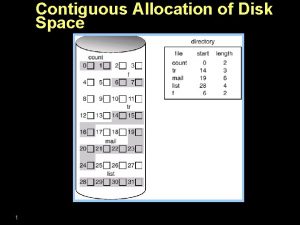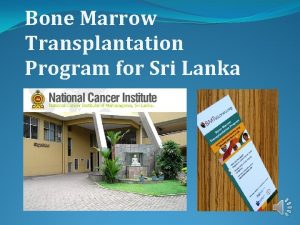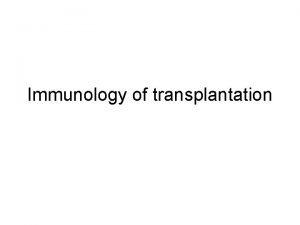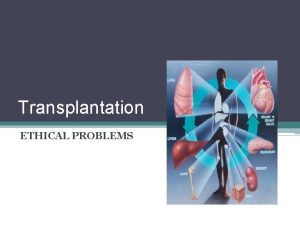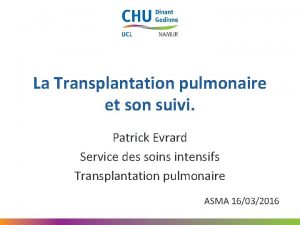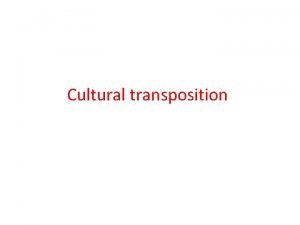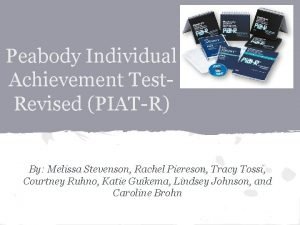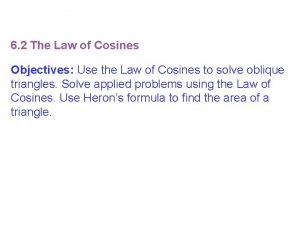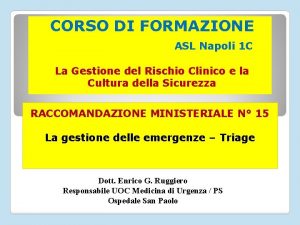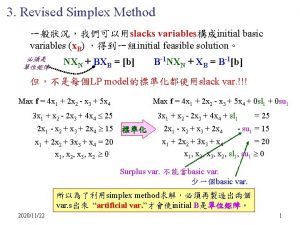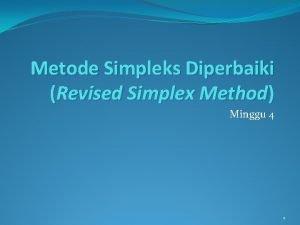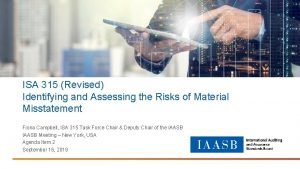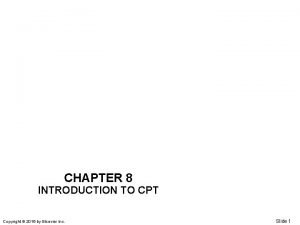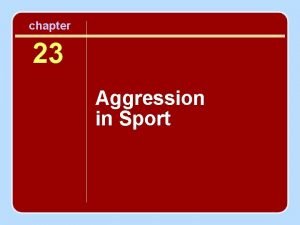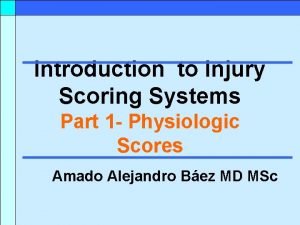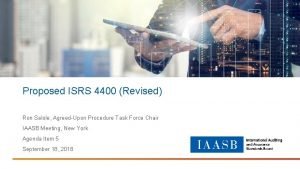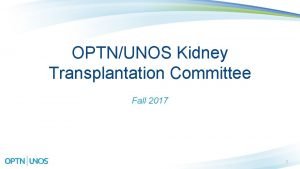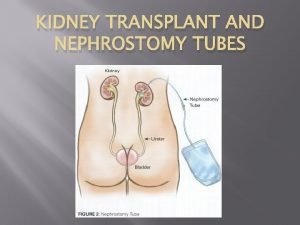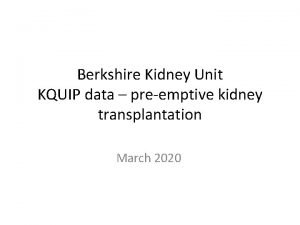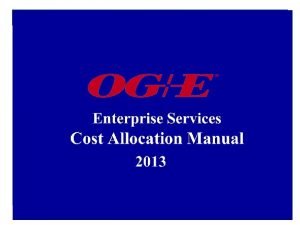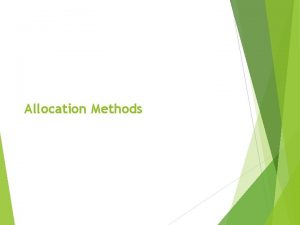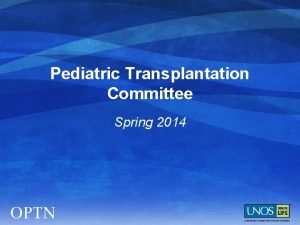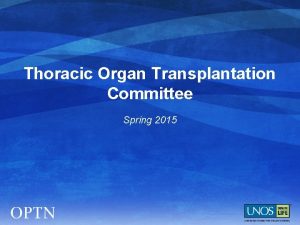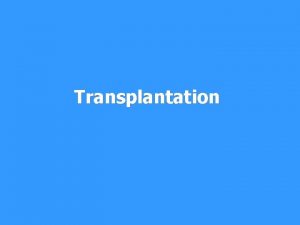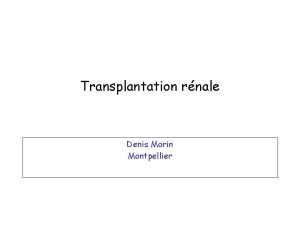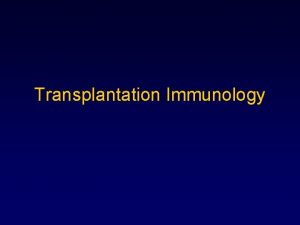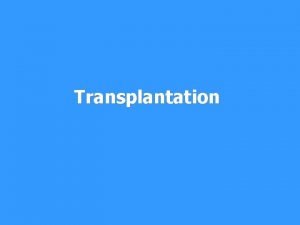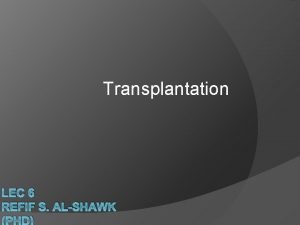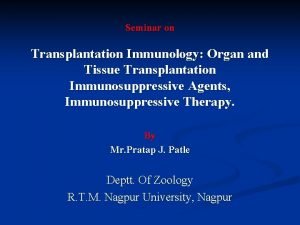Kidney Transplantation Committee Spring 2015 Revised Kidney Allocation




























- Slides: 28

Kidney Transplantation Committee Spring 2015

Revised Kidney Allocation System § Implemented Dec. 4, 2014 § 6 month data will be shared at Aug-Oct regional meetings § Monitoring community feedback to determine where clarification and tweaks may be needed in policy and UNet℠

How will KAS be monitored? 17+ data analyses, including: § Longevity matching: are fewer age or longevitymismatched transplants occurring? § Access: are high CPRA and blood type B patients getting more offers and transplants? What is the distribution of transplants by recipient age? § Utilization: have kidney discard rates decreased, in particular for high KDPI kidneys?

How will KAS be monitored? § Geography: are more kidneys being allocated outside of the local DSA? § Unintended consequences: § are fewer kidney patients being listed? § has the number of transplants for any demographic or clinically specific groups changed unexpectedly? § how often are shipped kidneys for CPRA 99 & 100 patients discarded or redirected? Analysis schedule: 6 months, 1 year, annually

Simultaneous Liver Kidney (SLK) Allocation Project The problem: § OPTN Final Rule requires allocation policies be: based on sound medical judgment and standardized criteria Ø seek to achieve the best use of organs Ø avoid futile transplants Ø § No standard rules or medical criteria specified in OPTN policy for SLK allocation § Current policy requires kidney to be allocated with liver if donor and candidate are in same DSA but does not specify rules for regional or national allocation § KAS and elimination of kidney payback system erased incentive for OPOs to share kidney with liver regionally

Important Historical Background § 2006 -2007—Societies hold consensus conference on the issue § 2009— Kidney and Liver Committees sponsor public comment proposal § § Majority of regions, individual commenters, and other committees supported proposed changes Varying concerns expressed from national groups (ASTS, NKF, AUA) § 2010—Committees decided not to move forward due to complex IT programming associated with proposal (mostly due to kidney allocation variances) and development of the new KAS § 2014—KAS is implemented, removing all variances

Different Perspectives on the Problem § OPO community perspective: No consistent rules beyond local distribution means the OPO is left to make the decision § Liver community perspective: This inconsistency is counter to goal the regional ‘Share 35’ liver policy seeks to achieve § Kidney community perspective: Some medical criteria should be required to ensure that kidney is not allocated to a candidate who may regain kidney function after liver-alone transplant because this diverts access from a kidney alone candidate

The Impact of the Problem by #’s 500—the approximate number of SLK transplants per year 50 -65—the number of SLK recipients with no pre-tx dialysis and serum creatinine < 2. 5 mg/dl. 110 -120—the number of recipients with <2 months of dialysis 48%--the percentage of kidneys used in SLK transplants that had KDPI < 35% (usually prioritized for peds)

2015 SLK Working Group Recommendations Medical eligibility criteria for SLK allocation 2 main policy elements “Safety Net” Prioritization on the kidney alone waiting list for liver recipients with post-operative dialysis dependency or significant renal dysfunction

Recommended SLK Eligibility Criteria Transplant nephrologist must confirm candidate has one of the following: And tx hospital must document one of the following in the medical record: 1. Chronic kidney disease 1. Dialysis for ESRD 2. e. GFR/Cr. Cl at or below 35 m. L/min 2. Sustained acute kidney non-function 1. Dialysis for six consecutive weeks 2. e. GFR/Cr. Cl at or below 25 m. L/min for at least six consecutive weeks 3. Any combination of #1 and #2 above for six consecutive weeks 3. Metabolic disease Diagnosis of: 1. Hyperoxaluria 2. Atypical HUS from mutations in factor H and possibly factor I 3. Familial non-neuropathic systemic amyloid 4. Methylmalonic aciduria

Recommended SLK Allocation Policy § If candidate meets the eligibility criteria, the OPO must allocate the kidney with the liver if allocation is local or regional before offering the kidney to a kidney-alone candidate

Data Reviewed for Safety Net Recommendations 19%--Of those liver recipients listed for a kidney, this is the percentage listed within 1 year after LI tx (the median is 6. 5 years) 93%--Of those liver recipients receiving a kidney tx, the percentage of KI tx performed more than a year after LI tx (40%-41% are performed 9 years+ after LI tx) 6 months—the amount of time after LI alone tx when the risk of newly developed ESRD is at its highest according to the literature

Recommended ‘Safety Net’ Policy § If, 2 -12 months after a liver transplant, a liver recipient is registered for a kidney and: § § has begun dialysis for ESRD or has an e. GFR at or below 20 m. L/min § The candidate will receive additional priority on the kidney waiting list § Once the candidate meets this criteria, the candidate will continue to be eligible for additional priority.

Sequence A KDPI <=20% Highly Sensitized 0 -ABDRmm Prior living donor Local pediatrics Local top 20% EPTS 0 -ABDRmm (all) Local (all) Regional pediatrics Regional (top 20%) Regional (all) National pediatrics National (top 20%) National (all) Sequence B Sequence C Sequence D KDPI >20% but <35% Highly Sensitized 0 -ABDRmm Prior living donor Local pediatrics KDPI >=35% but <=85% Highly Sensitized 0 -ABDRmm Prior living donor KDPI>85% SLK safety net Local adults Regional pediatrics National Regional adults National pediatrics National adults Highly Sensitized 0 -ABDRmm SLK safety net Local + Regional National

Next Steps § Seeking feedback from: § § § Regions Professional transplant societies and national groups Other Committees § Committees will reconvene in Spring to review feedback/finalize a public comment proposal for Fall 2015 § Explore and discuss application of these changes to heart/kidney and lung/kidney allocation

Comments/Questions? § Richard Formica, MD Committee Chair richard. formica@yale. edu § Regional Rep name (RA will complete) Region X Representative email address § Gena Boyle, MPA Committee Liaison gena. boyle@unos. org

Extras

Survival advantage of receiving a KI Purpose: Provide evidence supporting SLK eligibility criteria

Crude survival advantage of receiving a kidney vs. liver alone Recipient survival p-value=0. 0007 * Medians are shown LI Alone SLK White 70% 62% Diabetes 27% 41% MELD* 36 27 KDPI% 50 40 Age* 55 56 LI CIT* 6. 9 6. 4 LI Alone SLK White 73% 65% Diabetes 23% 38% MELD* 17 28 KDPI% 50 40 Age* 55 57 LI CIT* 6. 7 6. 5 Cohort: recipients Mar 31, 2002 – Dec 21, 2012

KI graft survival for SLK vs. KI alone … and Heart-Kidney Purpose: Assess degree of decrease in kidney graft survival in multi-organ transplants

Kidney graft survival White Age (median) Recipient survival SLK (ren. failure) SLK (no ren. failure) KI 62% 65% 45% 56 57 54 Cohort: recipients Mar 31, 2002 – Dec 21, 2012

Kidney graft survival Cohort: recipients Mar 31, 2002 – Dec 21, 2012

The effect of a previous LI tx on KI waiting list and recipient survival Purpose: provide evidence supporting the use of the safety net

Kidney patient survival: with vs. without prior liver tx Waiting list survival White Age (median) Recipient survival With LI (<=1) With LI (>1) W/t LI 75% 74% 45% 57 59 53 White Age (median) With LI (<=3) With LI (>3) W/t LI 70% 78% 45% 57 60 54 Time period: Mar 31, 2002 – Dec 21, 2012

Summary Eligibility criteria: survival advantage of receiving a KI SLK: lower KI graft survival rates Safety net: KI after LI transplant

Predicting ESRD* after LI tx Israni, at al Am J Transplant 2013; 13: 1782– 1792 Hazard function for ESRD (post MELD) Post MELD: risk of ESRD is highest in the first 6 m Incidence of ESRD in post MELD vs pre: - 6 m – increased - 6 m to 5 yrs – stable Post MELD: cumulative incidence of ESRD is 5. 1% during 5 years post tx * Initiation of maintenance dialysis therapy, KI tx or listing for KI tx

SLK Working Group § Kidney Transplantation Committee § Liver and Intestinal Organ Transplantation Committee § OPO Committee § Ethics Committee § Minority Affairs Committee § Operations and Safety Committee

Achieving a Balance Access Utility
 Contiguous allocation vs linked allocation
Contiguous allocation vs linked allocation Bone marrow transplantation sri lanka
Bone marrow transplantation sri lanka How does a kidney transplant work
How does a kidney transplant work Law of transplantation
Law of transplantation Stem cell or bone marrow transplantation thailand
Stem cell or bone marrow transplantation thailand Patrick evrard transplantation
Patrick evrard transplantation Cultural transposition
Cultural transposition Spring break 2015
Spring break 2015 Spring, summer, fall, winter... and spring (2003)
Spring, summer, fall, winter... and spring (2003) Autumn season months
Autumn season months Peabody testi formu
Peabody testi formu 2020 revised curriculum and assessment plans
2020 revised curriculum and assessment plans General ledger grade 9
General ledger grade 9 Solving sss triangle
Solving sss triangle 2020 revised curriculum and assessment plans
2020 revised curriculum and assessment plans Revised trauma score italiano
Revised trauma score italiano Two phase method example
Two phase method example Otes2.0
Otes2.0 Metode revised simplex
Metode revised simplex Isa 315 (revised)
Isa 315 (revised) Which cpt symbol is used to convey a revised code
Which cpt symbol is used to convey a revised code 2021 revised curriculum and assessment plans
2021 revised curriculum and assessment plans 2020 revised curriculum and assessment plans grade 6
2020 revised curriculum and assessment plans grade 6 Revised primary curriculum grade 1-3
Revised primary curriculum grade 1-3 What can trigger spectator aggression in sport
What can trigger spectator aggression in sport 2020 revised curriculum and assessment plans grade 6
2020 revised curriculum and assessment plans grade 6 Revised curriculum 2020
Revised curriculum 2020 Rts score
Rts score Csrs 4400
Csrs 4400
